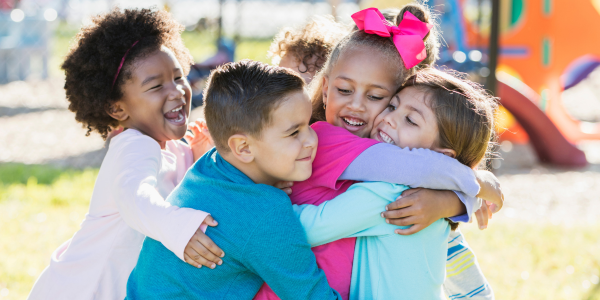How We Can Strengthen our Community and Build a Brighter Future
02/07/25

The unique differences, backgrounds, lived experiences, and cultural perspectives of the people around us are not just a strength, but a vital force that shapes our communities, driving progress and creating a more vibrant world of possibilities for children and adults. A multiplicity of backgrounds, cultures, and ideas allow us to learn and grow. In addition, for our communities, classrooms, and society to flourish, we must address and prevent inequities that keep individuals from full participation in that growth. When we do this, the results are clear — we are stronger together.

Identifying Barriers to Build Stronger Communities
Creating a community where everyone has the opportunity to succeed requires recognizing and addressing challenges that may exist. For example, data from our 2024 Child Care Provider Survey demonstrates the racial disparities within central Ohio’s child care sector and the children served. According to the report, 65% of white child care professionals reported that they would not need any additional public support to stay open, compared to less than 30% of Black child care professionals. Moreover, Black child care professionals are experiencing higher levels of economic instability. Monthly revenue covers the monthly operating expenses for only 39% of Black professionals, compared to 60% of white professionals.
Read more in our Dedication Through Difficulty Survey Report
In order for all child care professionals and the children they serve to thrive, we have to understand where the gaps are and acknowledge the barriers that may be causing those gaps. When we do this, we are more effective in identifying areas where we as a community can improve.
The disparities in child care access and sustainability are a reminder that progress cannot be achieved without addressing inequities.
Action for Children is committed to meaningful action that supports equity and justice within our local systems and we want to encourage you, as advocates, to do the same.

Building a Brighter Future Starts with Parents, Guardians, and Caregivers
One of the best ways we can ensure that future generations have inclusive and equitable opportunities to thrive is to start young. While early childhood may seem too soon to start addressing topics of equity and inclusion, data shows that children start noticing skin color as young as six months old, and can learn racial bias by the time they are four years old. Parents and caregivers play a crucial role in helping children understand, appreciate, and normalize differences in a positive way.

Teaching Empathy: Small Moments for Stronger Communities
The good news is, these conversations don’t have to feel like lectures. Engaging in everyday conversation and using available resources can make these learning opportunities more accessible and meaningful. Programs like Sesame Street explore belonging and community, and local resources, such as Action for Children’s Diverse Book List, guide for teaching children about Black History Month, and conversation starters for children’s books, provide tools to introduce these topics in an age-appropriate manner.
Speaking positively about the many variations present in our lives – not just people – teaches children that diversity is not only valuable, but also natural and normal. For example, while looking at paint chips, you can notice out loud that there are many shades of blue, but they’re still all blue. Fall leaves come in so many shapes and colors, but are all beautiful and fun to play in. In the same way, people come in all different shades and shapes. This diversity is important, valuable, and normal. By working these tips and resources into lesson plans and bedtime stories, parents and caregivers can ensure that their children are informed and secure as they grow and form opinions on themselves and others.
Modeling empathy and respect is another key way to help children appreciate differences and understand why respecting and including everyone is so important.
Ninety percent of brain development happens by age 5, and much of this development occurs by children watching, listening to, and engaging with those around them.
Children are extra sensitive to their surroundings, and their environment strongly impacts their social, emotional, and cognitive skills later in life. When caregivers—whether this be a biological parent, child care professional, foster parent, or another compassionate adult—consistently show respect and empathy to those around them regardless of skin color or any other part of a person’s identity, they model acceptance and respect, and help raise accepting and respectful children.
Read More: How to Help Your Child Develop Empathy (Zero to Three)

We Are Stronger Together: Building a Community Where All Children Can Thrive
At Action for Children, we believe that we are stronger when we work hand-in-hand, supporting one another to create lasting change for children and families. Our work will continue to foster spaces where parents, educators, and professionals can connect and grow. And as we collaborate with others and honor the broad array of individuals who make up our communities, we are reminded that diversity truly does strengthen our community and help us build a brighter future.
Author: Shea McHugh, Advocacy Associate at Action for Children
Action for Children is the local child care resource and referral agency for central Ohio, and is committed to assuring quality early learning experiences for all children. Our services focus on transforming the lives of children by supporting the everyday heroes who most influence our children’s early growth; care givers, educators, parents, and guardians. Learn More.